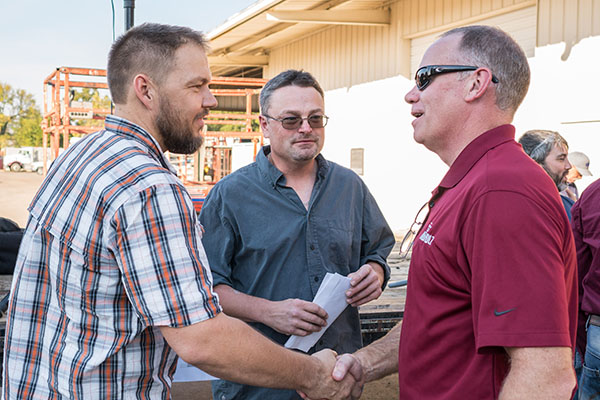The construction industry has a mixed past with safety. We’ve all seen photos of men constructing the Rockefeller Building in New York, hundreds of feet in the air with no fall protection. Safety was an afterthought to schedule and profit. It wasn’t until the 1970s that Richard Nixon signed OSHA (Occupational Safety and Health Administration) into creation in response to public outcry to rising injury and death rates on the job.
Since the 1970s, a lot has changed on construction jobsites. OSHA can now randomly inspect jobsites, and when merited, fine construction companies for unsafe practices. However, sometimes the pressure of increasingly accelerated schedules can cause workers (and company leadership) to shift their focus away from safety, and back onto deadlines.
How has Nabholz avoided this? And how can other companies achieve this? Here’s what our company did, and how we’ve achieved an EMR rating nearly half the industry average.
- Get Serious about personal responsibility.
In construction, danger is around every corner. From Gradalls tipping over to a saw malfunctioning, the potential for accidents on a construction site necessitates constant awareness. That’s why I see safety as my personal responsibility. I am responsible for going home in the same condition I arrived in, recognizing risks before they appear, stopping unsafe work when I see it, and keeping my brother alive.
To achieve zero accidents, I must personally believe that the concept of zero accidents IS achievable and live by that commitment.

Employee receives prize money for safety catch at company yard party.
- Incentivize if necessary.
Once I’ve bought into safety as my personal responsibility, how do I convince others- such as younger craftsmen who feel invincible- to get on board? I’ve learned to speak in their language, which is more often or not money.
At Nabholz, we have a program where employees can nominate other employees who stop unsafe work and prevent a probable accident from occurring. For instance, if one of our industrial craftsmen sees a fellow craftsman stop an employee from repairing a machine that has not properly been shut down, that employee could be nominated for a prize.
Nabholz gives $500 to each monthly winner, and $100 to the person nominated. At the end of the year, our executive leadership chooses grand prize winners and awards the top entry $2,000.
We also celebrate safe work with lunches, dinners, parties, t-shirts, hats, and more. How do we afford all of this? The more important question would be, how could we afford not to?
On average, a serious slip, trip or fall accident (the leading cause of worker death after motor vehicle injuries) costs employers $40,000.* (According to the Center for Disease Control and Prevention and the Bureau of Labor Statistics) In addition, studies show every $1 invested in injury prevention returns between $2 and $6. (Source: National Safety Council, “Injury Facts,” 2014 edition).
- Buy-In From Leadership
Rousing speeches, flashy marketing campaigns, and catchy slogans are great, but nothing will take the place of buy-in from company leadership. If company leadership doesn’t put safety first, it will be nearly impossible to convince others to do so.
At Nabholz, one way corporate buy-in is most evident is with our “I Stop Unsafe Work” campaign. Every employee, from a brand-new laborer to a seasoned superintendent, is given the authority to stop unsafe work, and given a card signed by Nabholz’ CEO as proof of this authorization. Nabholz’ leadership regularly assures employees they will never be reprimanded for shutting down unsafe work, even if it pushes back the schedule.

- Make Safety Part of the Company Culture
Creating a culture around safety is no easy feat, but Nabholz has boiled it down to this formula—empower, celebrate, repeat, and adapt.
First, empower employees. As we mentioned above, we give all employees the authority to stop unsafe work. Additionally, Nabholz was the first company in Arkansas to appoint a safety director, and now has multiple employees throughout the company dedicated entirely to safety. These employees operate with a high-degree of autonomy, and corporate leadership has given them the authority and power to enforce safety standards.
Second, celebrate. At Nabholz, we celebrate safety milestones with employee crawfish boils, yard parties, jobsite cookouts, and more. Usually, the company’s presidents and executive members are the ones cooking, illustrating that upper management is the first to celebrate the effort of Nabholz’ team in the field.
Third, repeat. Safety should always be top of mind, so every meeting should begin and close with a note on safety. Signage from safety campaigns should be in every jobsite trailer. T-shirts, hats, and wristbands can all tie into your company’s safety goals. Every time a member of your executive team speaks to a group internally, they should mention safety. Nabholz’ own CEO ends every email and letter to employees with a variation of “please continue to watch out for each other—every day, on every task.”
Fourth, adapt. Nabholz has adopted policies and procedures that exceed OSHA standards, and as a result, our company’s EMR rating is nearly half the industry average (.54). However, we can’t afford to rest on these laurels, as every day presents new challenges. This culture isn’t as easily built as erecting a steel frame structure. It is like building a sand castle — each wave takes a section out that needs rebuilding and reshaping. The thing about safety is it always evolving; as construction and technology continue to change, our culture must change with it.

